Life Sciences Paper 1 Grade 12 Questions - NSC Past Papers And Memos September 2020 Preparatory Examinations
Share via Whatsapp Join our WhatsApp Group Join our Telegram GroupINSTRUCTIONS AND INFORMATION
Read the following instructions carefully before answering the questions.
- Answer ALL the questions.
- Write ALL the answers in your ANSWER BOOK.
- Start the answer to EACH question at the top of a NEW page.
- Number the answers correctly according to the numbering system used in this question paper.
- Present your answers according to the instructions of each question.
- Do ALL drawings in pencil and label them in blue or black ink.
- Draw diagrams, tables or flow charts only when asked to do so.
- The diagrams in this question paper are NOT necessarily drawn to scale.
- Do NOT use graph paper.
- You may use a non-programmable calculator, protractor and a compass where necessary.
- Write neatly and legibly.
QUESTIONS
SECTION A
QUESTION 1
1.1 Various options are provided as possible answers to the following questions. Choose the answer and write only the letter (A–D) next to the question numbers (1.1.1–1.1.8) in the ANSWER BOOK, for example 1.1.9 D.
1.1.1 During Meiosis II …
- the chromosomes arrange at the equator of the cell in homologous pairs.
- the chromosome number is halved.
- chromosomes line up at the equator of the cell individually.
- whole chromosomes move to the opposite poles of the cell.
1.1.2 Which part of the male reproductive system secretes testosterone?
- Vas deferens
- Testis
- Seminal vesicle
- Prostate gland
1.1.3 The process by which ova are produced from the germinal epithelium of the ovaries is known as …
- gametogenesis.
- oogenesis.
- spermatogenesis.
- ovulation.
1.1.4 A ganglion is …
- an obstruction in a blood vessel.
- a collection of cells secreting hormones into the blood.
- a type of nerve cell involved in a reflex action.
- a collection of nerve cell bodies.
1.1.5 When the level of blood glucose rises, the body immediately reacts to lower the level by secreting …
- glycogen.
- insulin.
- glucagon.
- adrenalin.
1.1.6 The diagram below shows the direction of plumule (young stem) growth in various seedlings 1, 2, 3 and 4 placed in cardboard boxes. The arrows indicate the direction of light.
Which ONE of the above seedlings shows the correct response to light?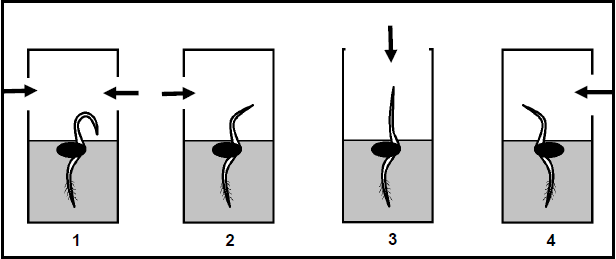
- 1
- 2
- 3
- 4
1.1.7 Which ONE of the following responses is expected if the growing tip of seedling 4 is cut after 4 weeks of growth?
- The plant will die
- Lateral branches will be formed
- The plant will stop growing
- The stem of the plant will grow towards gravity
1.1.8 The graph below shows the results of an investigation on the effect of blood alcohol concentration on reaction time (the time taken to react to an external stimulus).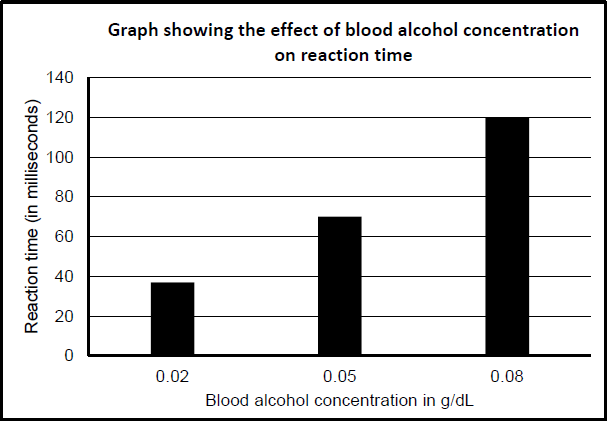
What conclusion can be drawn from the result of the investigation shown above?
The high level of blood alcohol concentration …
- has no effect on reaction time.
- decreases the reaction time.
- increases one’s ability to react faster.
- increases the reaction time. (8 x 2) (16)
1.2 Give the correct biological term for each of the following descriptions. Write only the term next to the question numbers (1.2.1–1.2.7) in the ANSWER BOOK.
1.2.1 The increase of the internal diameter of blood vessels so that more blood flows through them
1.2.2 The heat-regulating centre in the brain
1.2.3 A phenomenon where an increase in one hormone inhibits the secretion of another hormone
1.2.4 The component of the autonomic nervous system that decreases the heartbeat back to normal
1.2.5 The hormone that regulates the salt concentration in the human body
1.2.6 The site of transmission of electric nerve impulses between two nerve cells (neurons) or between a neuron and a gland or muscle cell
1.2.7 A temporary organ that connects the developing fetus through the umbilical cord to the uterine wall (7 x 1) (7)
1.3 Indicate whether each of the descriptions in COLUMN I apply to A ONLY, B ONLY, BOTH A AND B or NONE of the items in COLUMN II. Write A only, B only, both A and B or none next to the question numbers (1.3.1–1.3.3) in the ANSWER BOOK.
COLUMN I | COLUMN II | |
1.3.1 Endocrine glands in a human | A: | Cowper’s gland |
body | B: | Gastric glands |
1.3.2 The blood vessel that transports | A: | Umbilical vein |
oxygen and nutrients from the | B: | Umbilical cord |
mother’s body to the foetus | ||
1.3.3 Brings about elongation of | A: | Gibberellins |
internodes of stems | B: | Abscisic acid |
(3 x 2) (6)
1.4 The diagram below shows the regions (A, B and E) of the nervous system that can be blocked by local anaesthetic (a drug or agent that produces a complete or partial loss of feeling) for various medical procedures.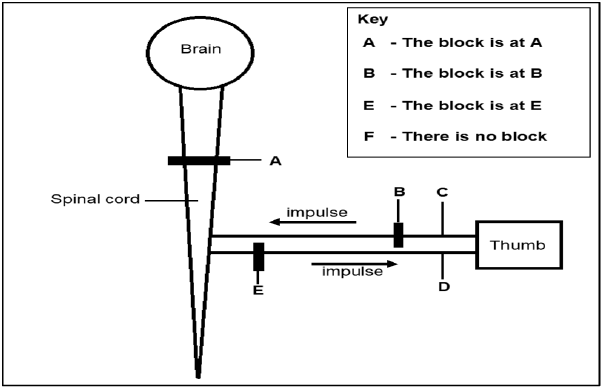
1.4.1 Write down the correct letter for each statement, using the key given in the diagram above.
- When the skin of the thumb is stimulated, the thumb and the hand move involuntarily, but the patient cannot move the hand voluntarily or feel it move. (1)
- The patient can feel the thumb being touched or pinched, but cannot move the thumb. (1)
- The patient can move the thumb, but cannot feel the movement. (1)
- When the skin of the thumb is stimulated, the thumb moves, and the patient knows it is moving. (1)
1.4.2 Which labelled part of the central nervous system will be actively involved to generate a quick response in a normal and healthy person, when the thumb accidently touches a hot surface? (1)
1.4.3 Name the type of reaction mentioned in QUESTION 1.4.2. (1)
1.4.4 Which TWO parts shown in the diagram are protected by meninges? (2)
1.4.5 Identify the letter representing the peripheral nerve that is composed of:
- Sensory neurons (1)
- Motor neurons (1)
1.5 The diagram below shows the female reproductive organs. Two tubes were cut and tied by means of a surgical procedure to prevent pregnancy.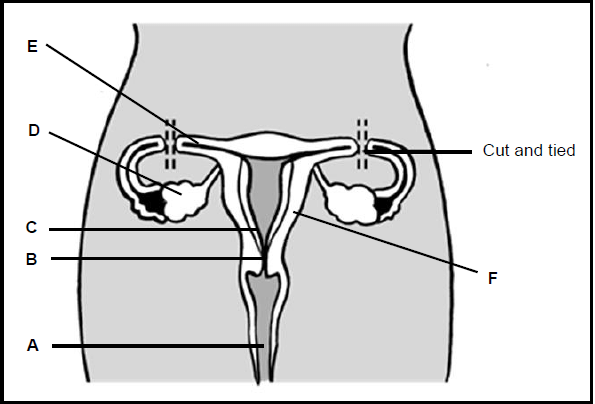
1.5.1 Identify:
- A (1)
- B (1)
- F (1)
1.5.2 Give the LETTER and NAME of the part:
- Where the embryo is implanted (2)
- That produces ova (2)
- Where fertilisation normally takes place (2)
1.5.3 How does the surgical procedure mentioned above prevent pregnancy? (1)
1.5.4 Give a reason for the surgical procedure performed on both tubes. (1)
TOTAL SECTION A: 50
SECTION B
QUESTION 2
2.1 The diagram below represents two stages of meiotic division.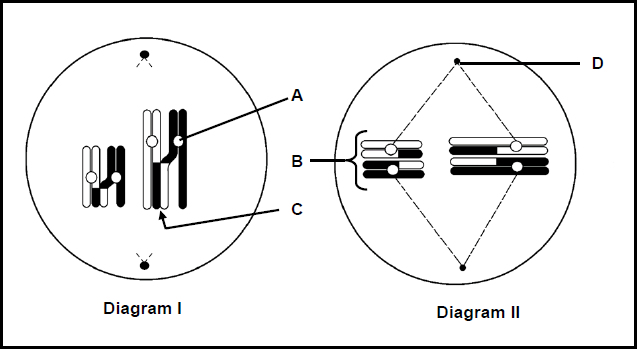
2.1.1 Identify the stage of meiosis represented by:
- Diagram I (1)
- Diagram II (1)
2.1.2 Identify:
- A (1)
- B (1)
- D (1)
2.1.3 Describe the process that takes place at C. (4)
2.1.4 Explain the significance of the event shown in Diagram II. (3)
2.2 The diagram below shows one of the developmental strategies prevalent among a certain bird species.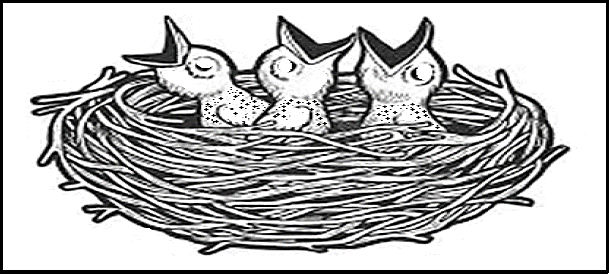
2.2.1 Identify the developmental strategy shown in the diagram. (1)
2.2.2 Give THREE observable reasons for the answer in QUESTION 2.2.1. (3)
2.2.3 State ONE possible disadvantage of this developmental strategy. (1)
2.2.4 Explain the physical appearance of the hatchlings by referring to their egg content. (2)
2.3 The diagram below shows a defective eye structure.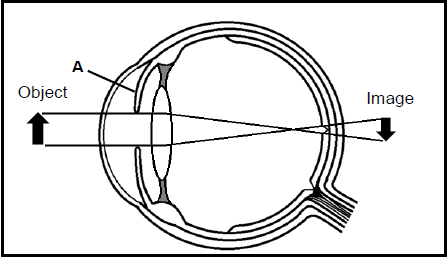
2.3.1 Identify the eye defect shown in the diagram. (1)
2.3.2 By referring to the diagram, explain how the structural defects shown in the diagram, cause the eye condition mentioned in QUESTION 2.3.1. (4)
2.3.3 State ONE way in which this condition can be corrected. (1)
2.3.4 Describe how the part labelled A is able to control the incoming light under dim conditions after sunset. (4)
2.4 The graph below shows the female hormone levels during the menstrual cycle.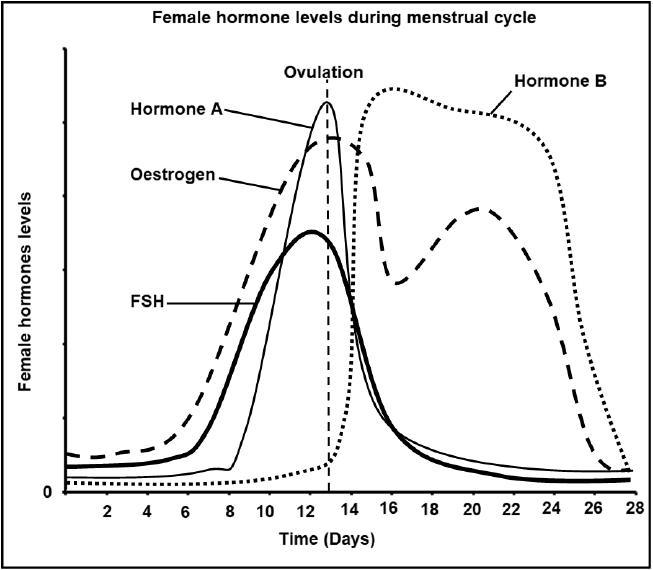
2.4.1 Identify hormone A. (1)
2.4.2 Give a reason for your answer in QUESTION 2.4.1. (1)
2.4.3 On which day of the cycle did ovulation take place? (1)
2.4.4 Describe the effect of oestrogen on the endometrium from the 7th to the 13th day of the cycle. (2)
2.4.5 The drop in the level of which hormone causes menstruation? (1)
2.4.6 Suggest a possible reason for the maintenance of a high level of hormone B beyond the 28 days of the cycle. (2)
2.4.7 Explain why the secretion of FSH is inhibited by the high levels of hormone B. (3)
[40 ]
QUESTION 3
3.1 An experiment was conducted to determine the effect of the hormone thyroxin on the body mass of Xenopus laevis frogs.
The procedure was as follows:
- Forty-four Xenopus laevis frog tadpoles were captured and divided into two equal groups.
- The average initial body mass of each of the groups was calculated before the start of the experiment.
- Twenty-two Xenopus laevis frog tadpoles were treated with a solution of thyroxin for 21 days.
- Twenty-two Xenopus laevis frog tadpoles were treated with 1% NaOH for 21 days.
- The treatment was stopped after 21 days and then the final average body mass for each group was calculated.
The results of the experiment are given below.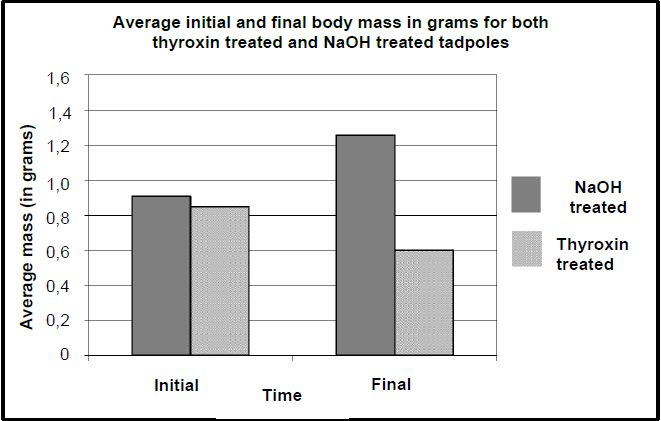
3.1.1 Name the gland that secretes thyroxin. (1)
3.1.2 Identify the independent variable in this experiment. (1)
3.1.3 State any TWO variables that should have been kept constant during the experiment. (2)
3.1.4 Which information displayed in the graph is used as baseline data to make a conclusion at the end of the experiment? (1)
3.1.5 Explain why there is a drop in the final body mass of the thyroxin treated tadpoles as compared to NaOH treated tadpoles. (4)
3.1.6 Describe how a constant level of thyroxin is maintained in the human blood when its level drops below the normal. (5)
3.2 The diagram below shows the structure of a human brain.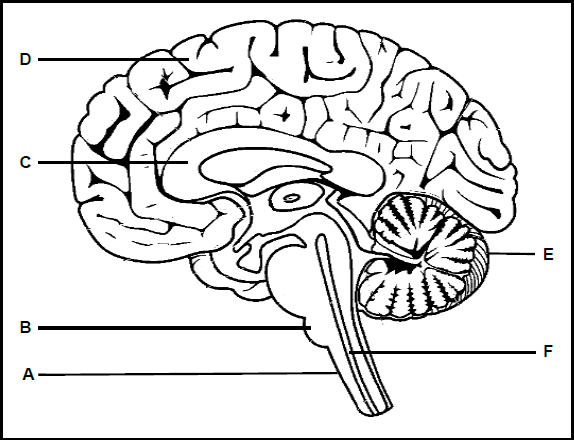
3.2.1 Identify the parts labelled:
- B (1)
- C (1)
- E (1)
3.2.2 Give ONE function of the:
- Part labelled A (1)
- Fluid found in the part labelled F (1)
3.2.3 A haemorrhage (excessive bleeding due to rupture of blood vessels) at the part labelled D may cause permanent dysfunction.
- Explain the cause of damage to the part labelled D. (3)
- State THREE possible consequences of the damage mentioned in QUESTION 3.2.3 (a) to a patient. (3)
3.3 An experiment was conducted to investigate the direction of plumule growth when the germinating seed was placed vertically on a stationary clinostat as shown in the diagram below. The growing tips of the germinating seed were exposed to light from all directions. The wet tissue paper was periodically sprayed with water to keep the seed moist. The seed was kept in this position for four days. The tip of the plumule began to bend and grew in an upward direction after four days.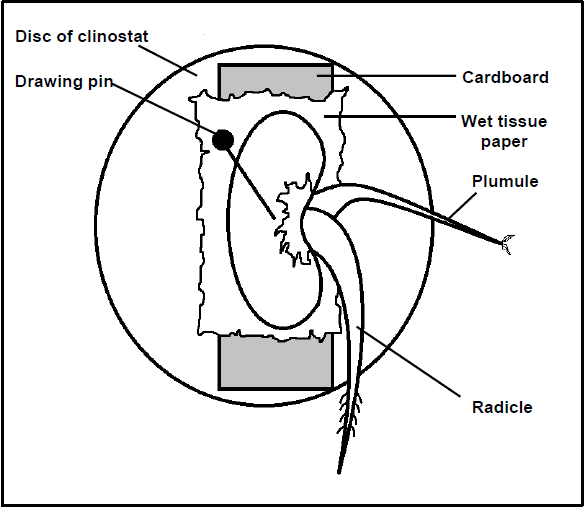
3.3.1 Name the hormone that controls the direction of plumule growth in a germinating seed. (1)
3.3.2 State where the hormone mentioned in QUESTION 3.3.1 can be located. (1)
3.3.3 Give a reason for exposing the germinating seed to light from all directions. (1)
3.3.4 Explain the direction of plumule growth as observed after four days. (4)
3.3.5 How does the control differ from the experiment? (1)
3.4 An extract detailing the scrotum is given below.
The scrotum is the loose pouch-like sac of skin that hangs behind the penis. It contains the testicles (also called testes), as well as many nerves and blood vessels. The scrotum has a protective function and acts as a climate control system for the testes. For normal sperm development, the testes must be at a temperature slightly cooler than the body temperature. Special muscles in the wall of the scrotum allow it to contract (tighten) and relax, moving the testicles closer to the body for warmth and protection or farther away from the body to cool the temperature. [Source: https://my.clevelandclinic.org/health/articles/9117-male-reproductive-system] |
3.4.1 From the extract, state TWO functions of the scrotum. (2)
3.4.2 Name the structure in which the sperms develop and mature. (1)
3.4.3 Explain the consequences on human reproduction if a male wears tight- fitting underwear all the time. (3)
3.4.4 What advice would you give to long-distance male drivers to minimise the possible adverse effect on their ability to reproduce? (1)
[40]
TOTAL SECTION B: 80
SECTION C
QUESTION 4
Mr Nkosi was trapped in a smoky room of a hotel which was on fire. His breathing rate increased as he was covered with thick smoke from the bottom floors. He was able to break the window and jumped out of his room. He landed on a street waste bin and managed to restore his balance.
Describe the process that led to an increased breathing rate while he was surrounded by thick smoke. Also describe how he was able to restore his balance when he landed on the street waste bin.
Content: (17)
Synthesis: (3)
[20]
NOTE: NO marks will be awarded for answers in the form of flow charts or diagrams.
TOTAL SECTION C: 20
GRAND TOTAL: 150